Overview
The key features of commercial sink faucets for architects encompass durability, design versatility, and advanced technology options, including touchless functionality, tailored to meet the demands of high-traffic environments.
Furthermore, selecting the right faucet is crucial, as it can significantly enhance both the aesthetic appeal and operational efficiency of commercial spaces.
Market trends support this assertion, indicating a growing preference for reliable and stylish fixtures.
In addition, architects must consider how these elements integrate into their designs, ensuring that functionality does not compromise visual appeal.
Introduction
Commercial sink faucets serve as vital components in high-traffic environments, where durability and functionality are paramount. As architects strive to achieve a delicate balance between design and practicality, it becomes essential to grasp the key features of these fixtures. With an increasing demand for innovative and hygienic solutions, the challenge lies in selecting faucets that not only satisfy rigorous performance standards but also elevate the overall aesthetic of commercial spaces.
What critical specifications should architects prioritize to ensure both efficiency and style in their designs?
Overview of Commercial Sink Faucets
Commercial sink faucets serve as vital fixtures tailored for high-traffic environments, including restaurants, hotels, and public restrooms. Engineered for exceptional durability, these fixtures are predominantly constructed from robust materials such as stainless steel or brass, known for their resistance to corrosion and wear. The market for commercial taps is projected to experience substantial growth, with a compound annual growth rate (CAGR) of 8.0% from 2025 to 2030. This trend underscores the increasing demand for reliable and efficient fixtures within the hospitality and service sectors. In 2024, the global tap market was valued at USD 23.28 billion, reflecting the significant size and growth potential of this industry.
These taps come in a variety of styles, including:
- Manual
- Metering
- Touchless models
Each designed to cater to specific user needs and preferences. Touchless taps, in particular, are witnessing a surge in popularity due to their hygienic advantages and convenience, positioning them as a preferred choice in modern washroom designs. The necessity of durability in commercial sink faucets is paramount; they must withstand the rigors of frequent use while maintaining both functionality and aesthetic appeal.
For example, The Splash Lab's projects, such as those executed for Lacuna Space in California and Padel Haus in New York, illustrate the successful integration of durable and stylish fixtures that enhance the overall bathroom experience. These case studies highlight the firm's commitment to quality craftsmanship and innovative solutions, ensuring that their products not only meet but exceed industry durability standards. As architects assess the layout of business facilities, it is crucial to understand the various options available and their associated benefits to create spaces that are both practical and visually appealing. Notably, taps in bathrooms accounted for over 59% of earnings in 2024, emphasizing the importance of selecting the right tap for business washroom designs.
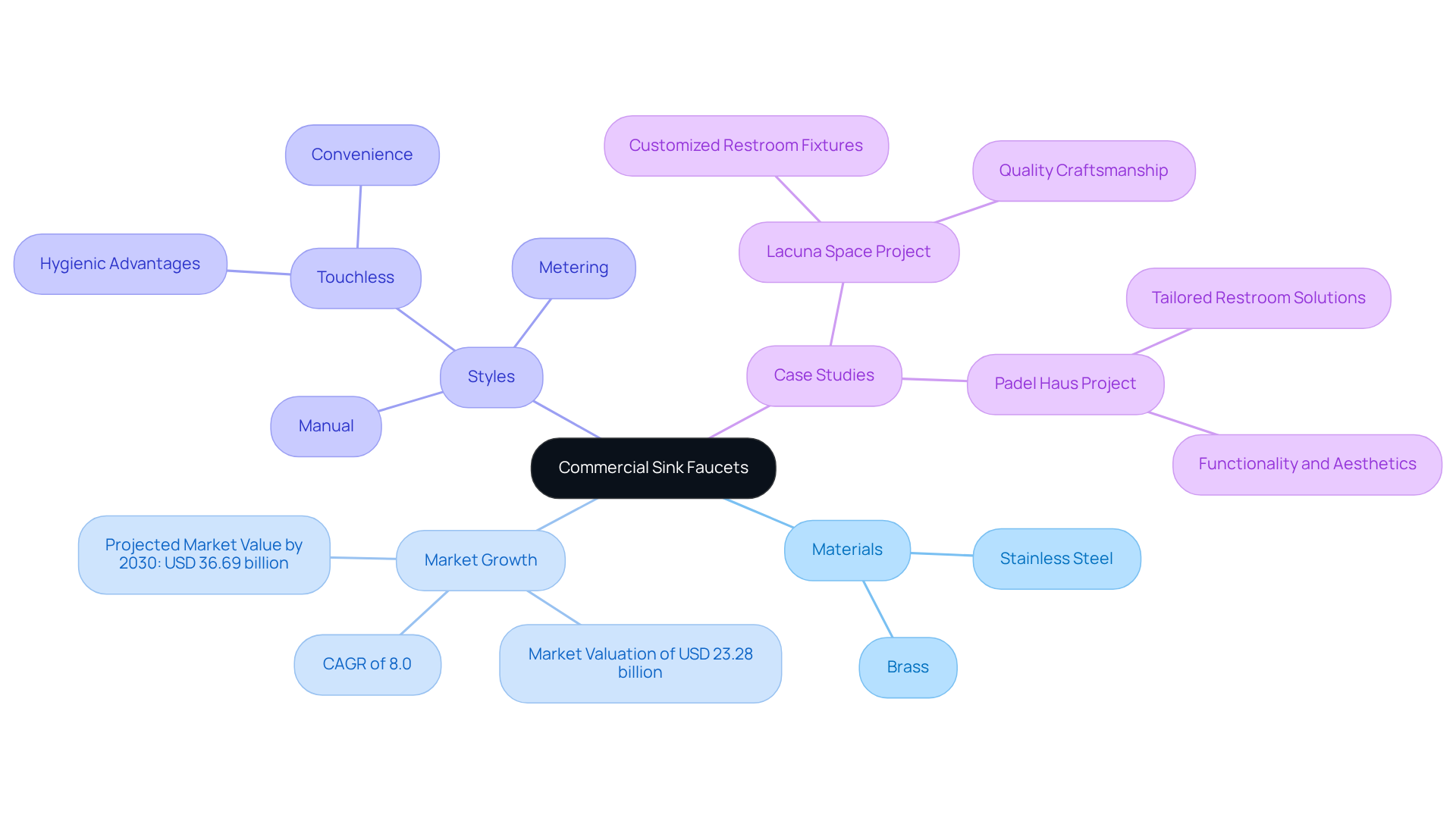
Key Features of Top Commercial Sink Faucets
Top commercial sink faucets are characterized by several essential features that enhance their functionality and suitability for high-use environments:
- Durability: These faucets are constructed from heavy-duty materials such as stainless steel or brass, ensuring longevity even in demanding conditions.
- Flow Rate: Many models of commercial sink faucets are engineered to comply with specific flow rate standards, typically ranging from 1.0 to 2.2 GPM, effectively balancing water conservation with optimal performance.
- Touchless Technology: Increasingly common, commercial sink faucets with touchless taps significantly improve cleanliness by reducing contact points, making them ideal for public restrooms.
- Ease of Maintenance: Features like removable aerators and straightforward cartridge replacements streamline maintenance for commercial sink faucets, which is crucial for facilities that experience high traffic.
- Design Versatility: Available in a variety of styles and finishes, commercial sink faucets allow architects to seamlessly integrate fixtures with the overall design theme of the restroom.
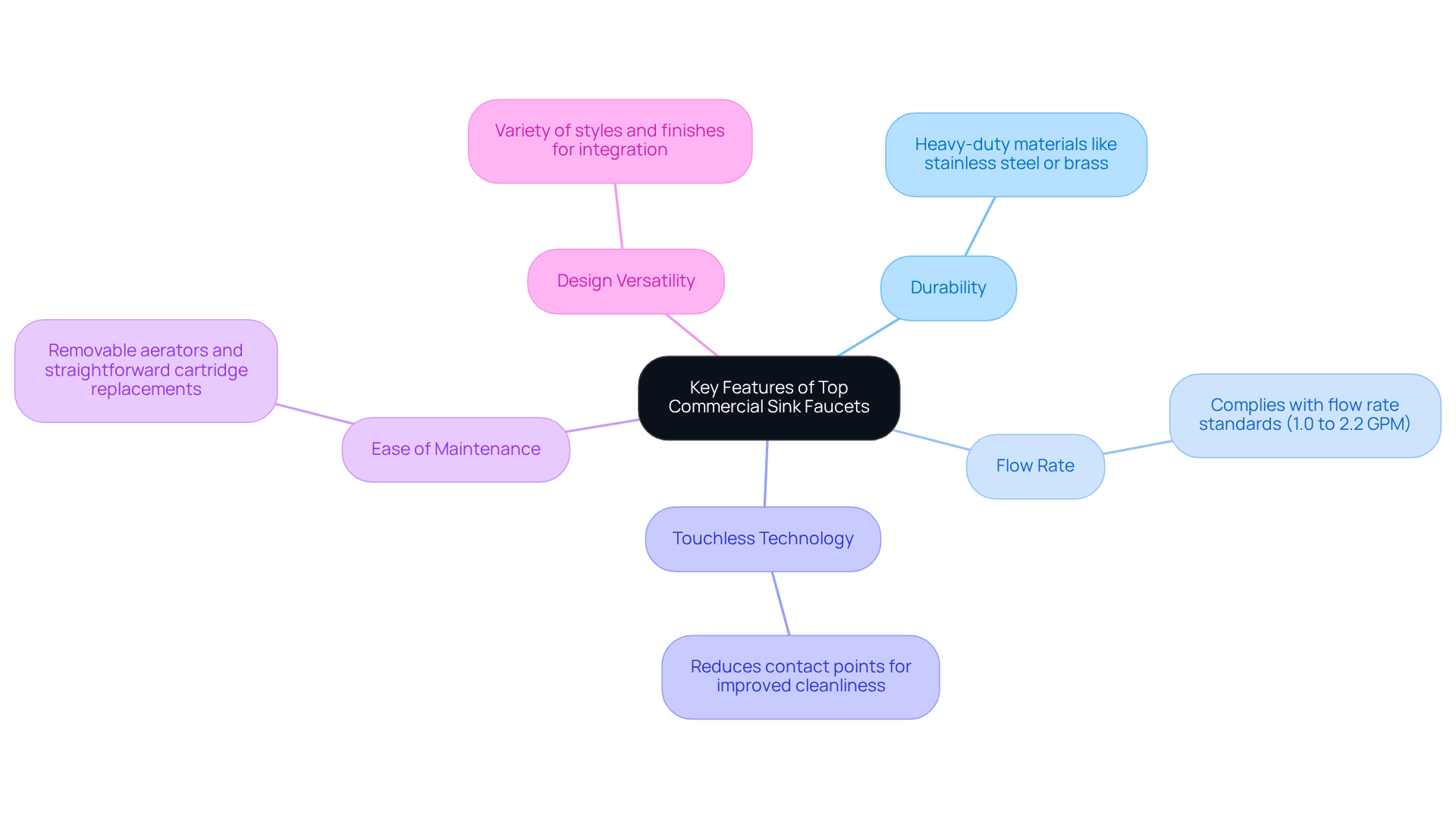
Durability and Maintenance Considerations
When assessing commercial sink faucets, durability is paramount. High-quality fixtures are crafted from materials designed to withstand corrosion, tarnishing, and wear, including stainless steel and solid brass. Notably, stainless steel surfaces lack pores, which effectively prevents the growth of bacteria and the production of odors—this is crucial for maintaining hygiene standards in professional environments. Regular maintenance is essential to prolong the lifespan of these fixtures. Key maintenance considerations include:
- Regular Cleaning: Routine cleaning prevents mineral buildup and preserves the faucet's appearance.
- Inspection for Leaks: Conducting regular checks for leaks can avert water damage and minimize water waste.
- Replacement Parts: Access to replacement parts is vital for maintaining functionality; many manufacturers provide warranties and support for parts replacement.
- User Education: Instructing facility personnel on correct usage and upkeep can significantly extend the lifespan of the fixtures. Proper training ensures that staff are aware of best practices, which is essential for effective maintenance.
- Water Quality Management: Installing a water softener or whole-house filter can mitigate hard water issues that negatively impact the lifespan of taps.
Adopting these practices not only extends the lifespan of commercial sink faucets but also upholds hygiene standards, which are essential in professional settings. Regular maintenance can prevent costly repairs, as statistics indicate that repair costs exceeding 50% of a new fixture often signal the need for replacement. By prioritizing these maintenance strategies, facility managers can ensure their fixtures remain efficient and dependable over time.
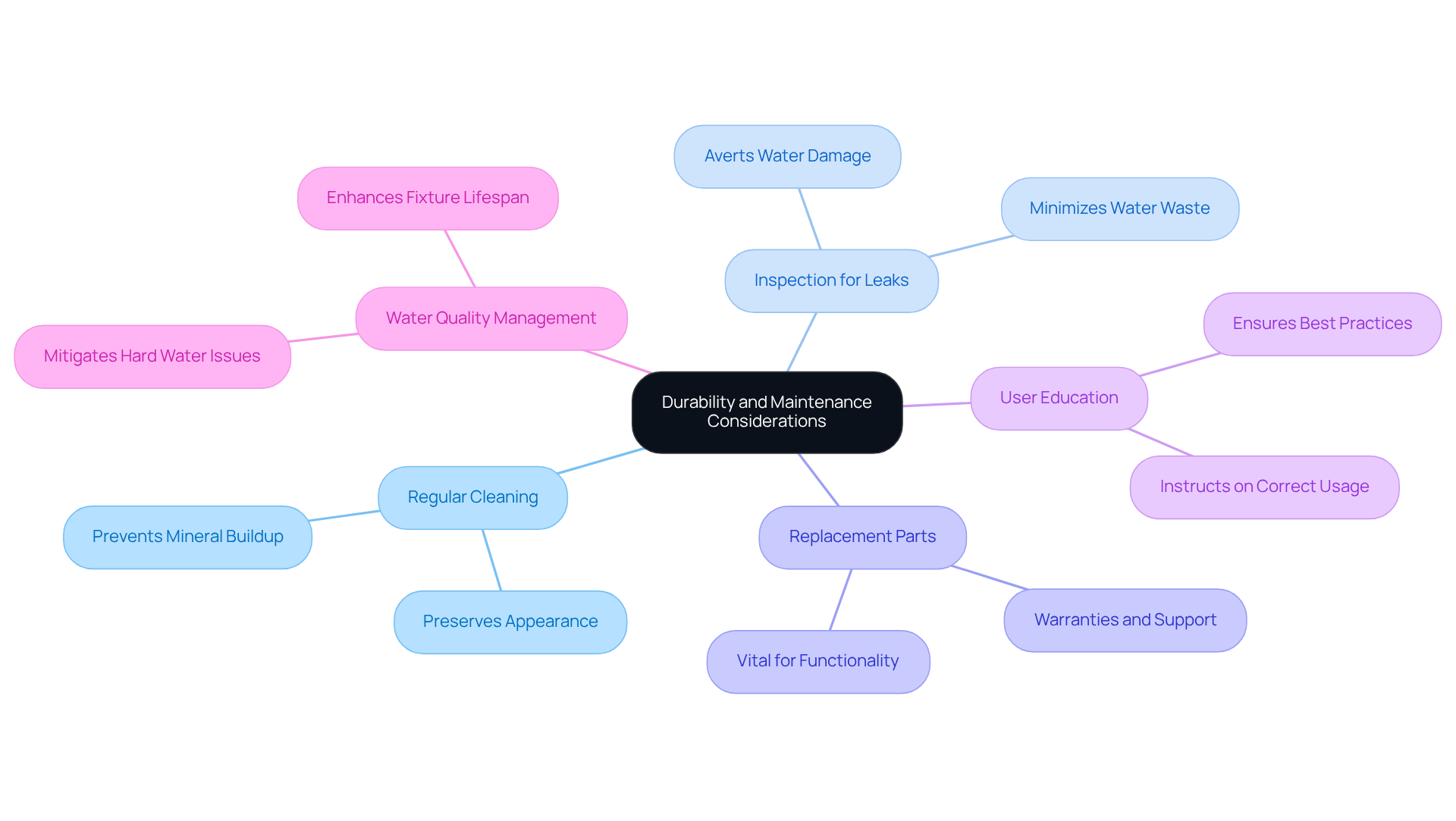
Design Aesthetics and Functional Integration
Visual appeal is paramount when selecting commercial sink faucets, as architects must ensure that the faucet's style, finish, and shape harmonize with the overall bathroom layout. Key considerations include:
- Finish Options: Faucets are available in a diverse range of finishes, such as chrome, brushed nickel, and matte black, allowing for tailored customization that enhances restroom decor. Matte black finishes, for example, not only provide a striking aesthetic but also resist fingerprints, thereby simplifying maintenance.
- Form and Function: The design of a tap should strike a balance between visual appeal and functionality. Important elements of commercial sink faucets include spout height, reach, and user-friendliness, ensuring that these fixtures are accessible to all patrons, including those with disabilities.
- Sustainability: Modern taps increasingly feature eco-friendly characteristics, such as low-flow aerators and integrated filtration systems, which contribute to water conservation efforts. This aligns with the growing demand for sustainable practices in environments that feature commercial sink faucets.
- User Experience: The construction of the tap significantly impacts user experience. Research indicates that well-crafted taps can enhance overall satisfaction in washroom facilities, making them more appealing and practical for users. The global tap market is anticipated to grow at a CAGR of 8.0% from 2025 to 2030, highlighting the rising demand for contemporary taps and the importance of thoughtful selection in bathroom design.
Integrating these elements not only elevates the visual attractiveness of public bathrooms but also fosters eco-friendly practices and enhances user experiences. Thus, making informed fixture choices is a crucial aspect of effective bathroom planning.
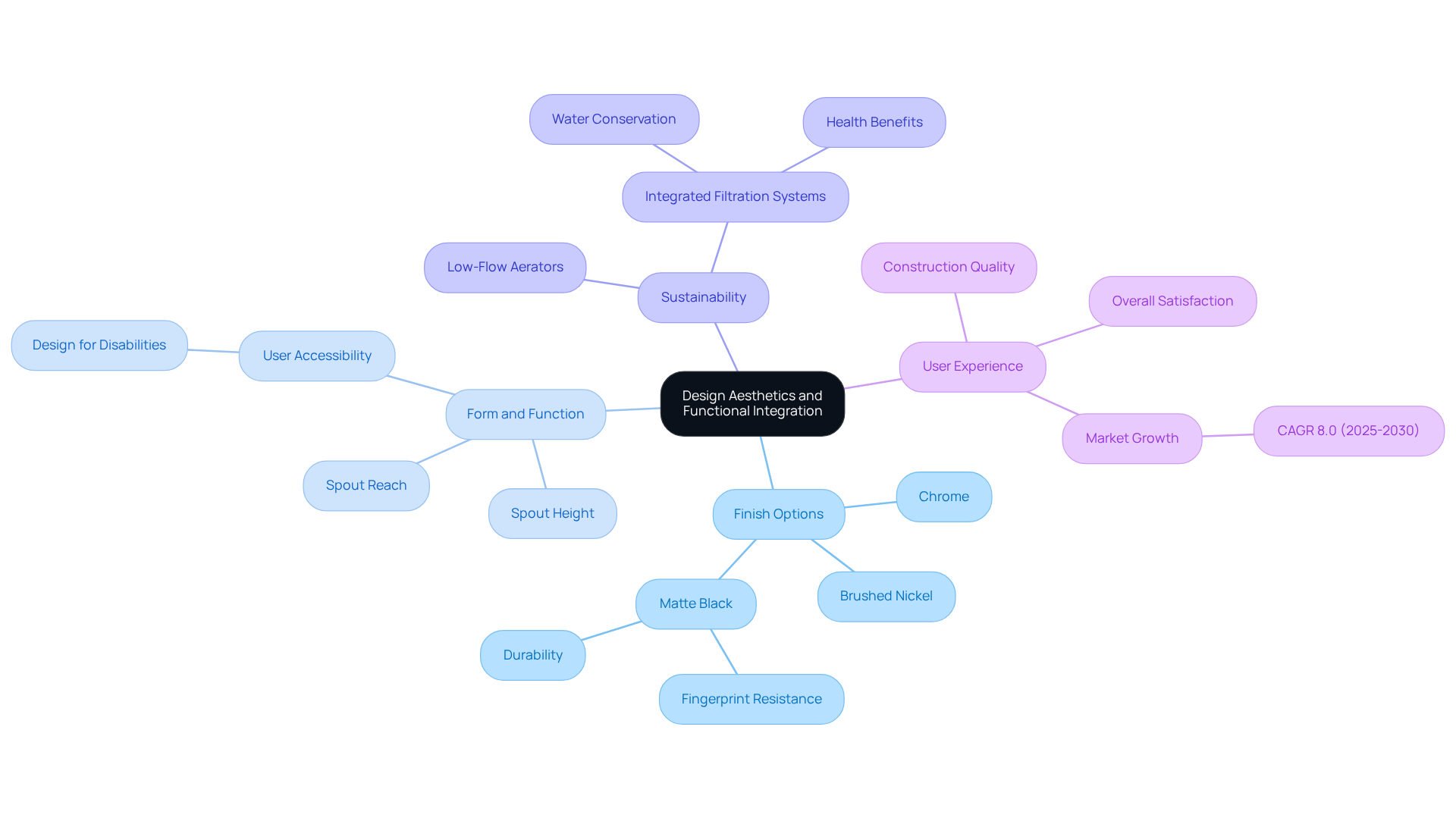
Comparison Summary: Best Choices for Commercial Applications
In summary, architects should consider the following top commercial sink faucets:
- Touchless Faucets: These are ideal for high-traffic restrooms, offering hygiene and convenience through sensor activation that minimizes contact.
- High-Arc Faucets: Providing ample clearance for filling pots and cleaning, these faucets are suitable for kitchens and utility areas, allowing for greater versatility in use.
- Wall-Mounted Faucets: These fixtures save counter space and deliver a clean look, perfect for modern designs, while also facilitating easier cleaning of surfaces.
- Durable Manual Taps: Reliable and easy to maintain, these fixtures are often preferred in environments where touchless options may not be feasible, ensuring consistent performance.
- Eco-Friendly Models: Designed with sustainability in mind, these faucets feature low-flow options that reduce water consumption without sacrificing performance, aligning with green building practices.
As noted by Brent Otsuka, Manager of Interior Design at Fentress Architects, "The Splash Lab has well-crafted and beautifully designed products. I consistently approach them first to create a comprehensively designed bathroom." This endorsement emphasizes the significance of choosing fixtures that enhance both utility and appearance in bathroom layouts. By carefully considering these options, architects can select faucets that not only fulfill their design vision but also contribute to sustainable and efficient restroom environments.
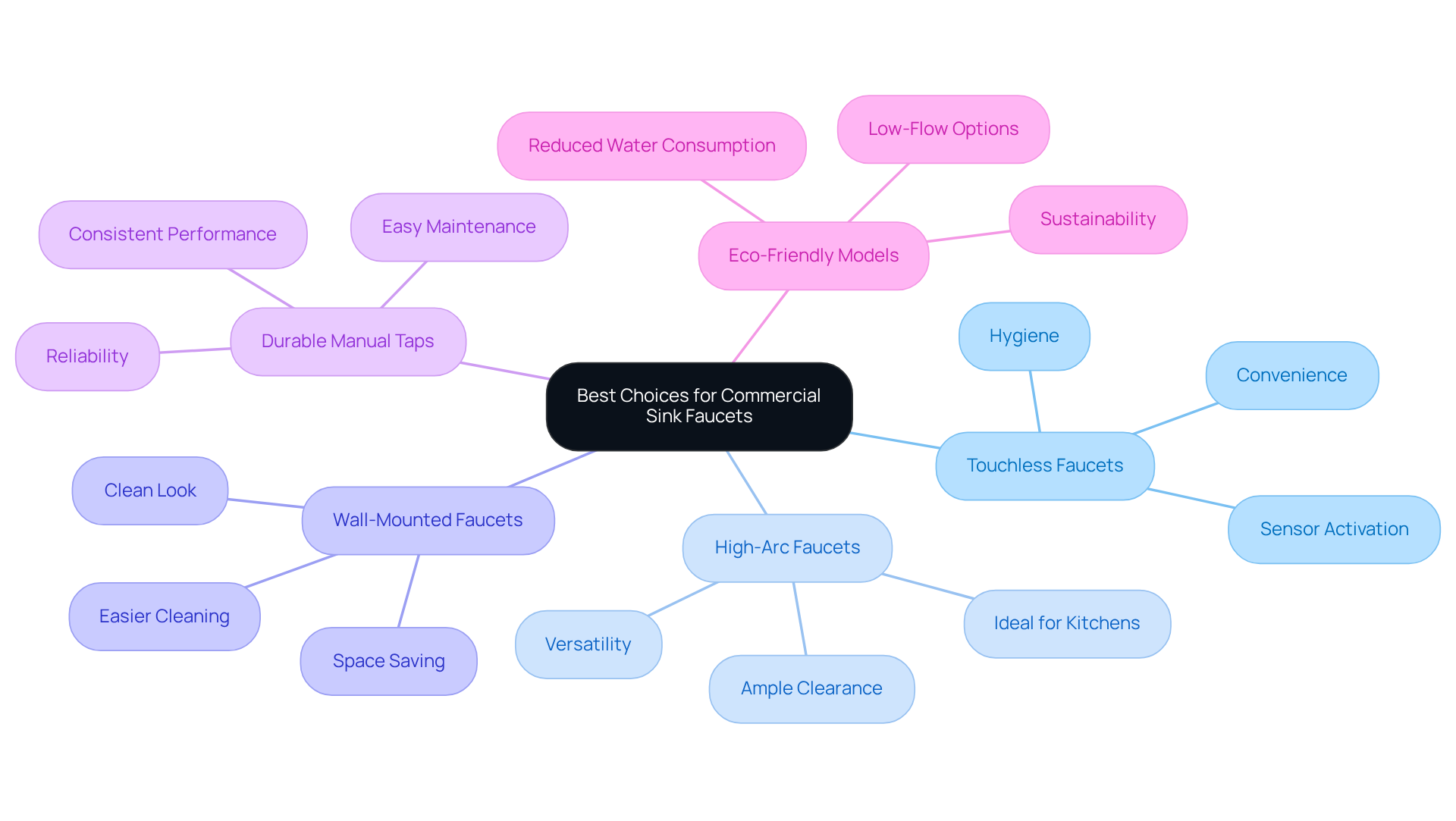
Conclusion
Selecting the right commercial sink faucet is a critical decision for architects aiming to create functional and aesthetically pleasing spaces. This selection process demands careful attention to durability, ease of maintenance, and design aesthetics, as these factors significantly contribute to overall efficiency and user experience in high-traffic environments. By comprehensively understanding the various styles and technologies available, architects can ensure their choices not only meet practical needs but also align with their design visions.
Key insights discussed include:
- The rise of touchless technology, which enhances hygiene and convenience.
- The significance of durable materials such as stainless steel and brass.
- The necessity of regular maintenance to prolong the lifespan of fixtures.
- The growing demand for eco-friendly options that promote sustainability without compromising performance.
Ultimately, the selection of commercial sink faucets should be approached with careful consideration of their features and benefits. As the market continues to evolve, architects have a unique opportunity to integrate innovative designs that not only fulfill user needs but also contribute to a sustainable future. By prioritizing these elements, architects can create spaces that are not only functional but also elevate the overall experience for users in commercial environments.
Frequently Asked Questions
What are commercial sink faucets used for?
Commercial sink faucets are vital fixtures designed for high-traffic environments such as restaurants, hotels, and public restrooms, providing durability and functionality.
What materials are commercial sink faucets typically made from?
They are predominantly constructed from robust materials like stainless steel or brass, which are known for their resistance to corrosion and wear.
What is the projected growth rate for the commercial tap market?
The market for commercial taps is projected to experience a compound annual growth rate (CAGR) of 8.0% from 2025 to 2030.
How much was the global tap market valued in 2024?
In 2024, the global tap market was valued at USD 23.28 billion.
What types of commercial sink faucets are available?
Commercial sink faucets come in various styles, including manual, metering, and touchless models, each designed to cater to specific user needs.
Why are touchless taps gaining popularity?
Touchless taps are becoming more popular due to their hygienic advantages and convenience, making them a preferred choice in modern washroom designs.
What are the key features of top commercial sink faucets?
Key features include durability, compliance with specific flow rate standards (typically 1.0 to 2.2 GPM), touchless technology, ease of maintenance, and design versatility.
How do commercial sink faucets contribute to cleanliness?
Touchless technology in commercial sink faucets significantly improves cleanliness by reducing contact points, making them ideal for public restrooms.
What maintenance features do commercial sink faucets offer?
Many models include removable aerators and straightforward cartridge replacements, which streamline maintenance in high-traffic facilities.
How important are taps in business washroom designs?
Taps in bathrooms accounted for over 59% of earnings in 2024, highlighting the importance of selecting the right tap for effective business washroom designs.




